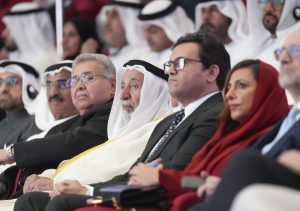SHARJAH / WAM
HH Sheikh Dr Sultan bin Mohammed Al Qasimi, Supreme Council Member and Ruler of Sharjah and Supreme
President of the Arabic Language Academy in Sharjah, launched the GPT “Historical Dictionary of the Arabic
Language” project. The event took place in the presence of Sheikha Bodour bint Sultan Al Qasimi, President of the American University of Sharjah.
The launch occurred during the First the Sharjah International Conference on AI & Linguistics (SICAL), taking place at the American University of Sharjah on October 17 and 18. This event is organised in collaboration with
the Emirates Scholar Centre for Research and Studies (ESCRS), part of the Emirates Foundation for Science and Research, and features over 50 distinguished speakers from education, scientific research, culture, and technology, along with notable leaders in academia and the tech industry.
HH emphasised the need to leverage modern technologies and artificial intelligence to support, preserve, and promote the Arabic language. He underscored the importance of addressing the challenges posed by technological advancements and AI to ensure they have a positive impact.
The Ruler of Sharjah watched a visual presentation about the first version of the GPT Dictionary project, which is the first reliable and highly credible digital platform based on artificial intelligence for the history and roots of Arabic vocabulary, where the efforts made to develop the dictionary were highlighted based on modern technologies that enhance the accuracy of research and ease of access to linguistic information. Dr Firas Habbal, President of ESCRS, and Dr Fawaz Habbal, Secretary-General of the centre, alongside Dr Mohamed Safi Al Mosteghanemi, Secretary General of Arabic Language Academy, highlighted several features of the GPT Dictionary. One notable feature is “Tahawar Ma’ie,” which enables non-Arabic speakers to listen to answers to their linguistic queries while selecting a preferred voice.
Dr Habbal explained, “We recognised that non-Arabic speakers often struggle with pronunciation and diacritics, so we introduced the (Tahawar Ma’ie) feature to make the dictionary accessible to everyone, not just experts.”
He highlighted the “Visual Expression” feature of the GPT Dictionary, stating, “We observed that most AI users prefer visual content on social media. In response, we developed this feature, allowing users to select templates from various social media platforms. The dictionary then generates a complete visual and audio video clip ready for publication.”
Dr. Amhamed Safi Al-Mostghanemi emphasised the significance of the “Historical Dictionary of the Arabic Language”. He stressed the necessity of integrating it with modern technologies to make it accessible to all Arabic speakers, including non-native speakers, and to align with contemporary practices in exploring the origins and meanings of vocabulary.
The launch of the GPT “Historical Dictionary of the Arabic Language” project aligns with the Emirate of Sharjah’s commitment to elevating the status of the Arabic language and safeguarding it from contemporary challenges. This initiative aims to leverage modern innovations to promote and spread the language globally.
Integrating the dictionary with artificial intelligence enables researchers and users to access over 20 million Arabic words. It also allows for text creation and reading, converting content into video clips. Additionally, a continuous information stream will be maintained through collaboration between the Arabic Language Academy in Sharjah and the Emirates Scholar Centre for Research and Studies.
The “Historical Dictionary of the Arabic Language” is a significant scientific achievement that documents the evolution of the Arabic language over time. By utilising artificial intelligence technologies, the dictionary enables users to trace word origins and their usage over the years, providing researchers and linguists with an advanced research tool. It also aims to enhance the use of Arabic vocabulary and promote its integration into modern technologies. Additionally, this project serves as a valuable educational resource that can support and enrich curricula in educational institutions.
 The Gulf Time Newspaper One of the finest business newspapers in the UAE brought to you by our professional writers and editors.
The Gulf Time Newspaper One of the finest business newspapers in the UAE brought to you by our professional writers and editors.
